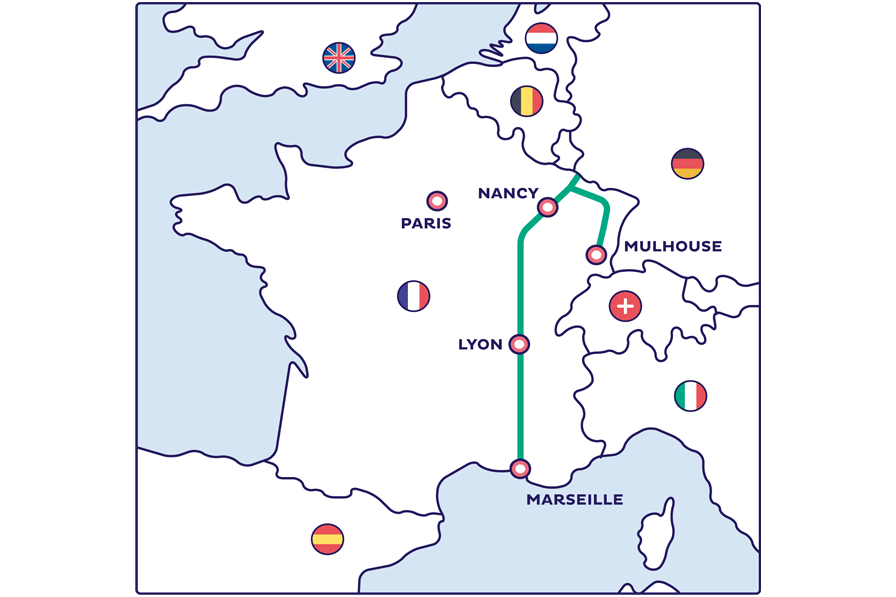HY-FEN

Description of project
HY-FEN is aimed at developing a hydrogen transport infrastructure from the south of France to the German border, in continuation of the BarMar project, connecting the Iberian peninsula, France and Germany via high-potential hydrogen valleys along its route in the Rhône valley, including major hydrogen storage projects.
Hydrogen for what use, planning and technical details
HY-FEN will enable the decarbonisation of the main industrial basins on its path in France and towards adjacent countries, in particular Germany. It will also be usable for the various mobility uses. Consequently, the project will be a key factor in the development of a renewable and low-carbon hydrogen market at the European level.
- 2020-2022: Preliminary studies for the design of a European hydrogen transport infrastructure as part of the “European Hydrogen Backbone”.
- 01/2023: France and Germany announce the extension of the H2Med project up to Germany, confirming the benefits of a corridor.
- 2023: Pre-feasibility study.
- 2030: Forecast commissioning date.
- Length: Approximately 1,200 km.
- Capacity: 200 GWh/d.
Information about the public debate
"Debating the Industrial Future of Fos Berre Provence" public debate
As requested by the Prefects of the Bouches-du-Rhône, Alpes-de-Haute-Provence and Gard departments of France, the National Commission for Public Debate (known as the CNDP in France) organised a comprehensive public debate on 11 December 2024 about the decarbonisation and reindustrialisation projects in the industrial zone of the Golfe de Fos, the Étang de Berre and their associated territories. The projects concerned include HY-FEN and HYnframed, led by NaTran.
How to take part in the public debate
- The CNDP website dedicated to the public debate
- The interactive public debate platform
- Interactive mapping tool
- Manual of procedures for granting authorisations for projects of common interest under EU regulation no. 347/2013 (currently being revised): Manual of procedures
Debate diary
>> Find the full schedule of public meetings on the debate website.
Note about the participation system
As part of the territorial debate requested by the Prefects of the Bouches-du-Rhône, Alpes-de-Haute-Provence and Gard departments of France, NaTran’s hydrogen transport pipeline project in the South of France - Provence-Alpes-Côte-d’Azur region is an integral part of the committed territorial debate and is presented in detail in this dossier. This territorial debate, organised in accordance with the provisions of Article L.121-9 of the French Environmental Code, takes the place of prior consultation for the project, whether mandatory, optional or voluntary, and meets the prerequisites of the concept of upstream public participation set out in Article 9 of EU Regulation 2022/869 [1] for the HyFen link and the GeoH2 link, both of which are included on the Union list of projects of common interest and projects of mutual interest published in the OJEU on 8 April 2024 [2].
In addition, in line with the principles set out in Article L.121-1 of the French Environmental Code, which encourages public information and participation upstream of decisions that have an environmental impact, the public debate also serves to clarify and enrich reflections about the project before it is implemented.
Therefore, no other specific prior consultation is required, as the territorial debate fully fulfils the mission of informing all stakeholders and discussing their views in compliance with the regulatory framework in force.
[1] Regulation of the European Parliament and of the Council of 30 May 2022 on guidelines for trans-European energy infrastructure, amending Regulations (EC) No 715/2009, (EU) 2019/942 and (EU) 2019/943 and Directives 2009/73/EC and (EU) 2019/944, and repealing Regulation (EU) No 347/2013
[2] Commission Delegated Regulation (EU) 2024/1041 of 28 November 2023 amending Regulation (EU) 2022/869 of the European Parliament and of the Council as regards the Union list of projects of common interest and projects of mutual interest.
The content of this document is the sole responsibility of the author and does not necessarily reflect the opinion of the European Union or CINEA.